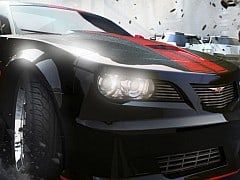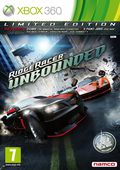You can trust VideoGamer. Our team of gaming experts spend hours testing and reviewing the latest games, to ensure you're reading the most comprehensive guide possible. Rest assured, all imagery and advice is unique and original. Check out how we test and review games here
Despite some early concerns, Namco’s decision to bestow one of its most prized titles – Riiiiidge Racer – upon FlatOut creator Bugbear was a good idea. If nothing else, the Finnish studio has attempted to whip the ailing racing franchise back into relevancy with a new-found focus on vehicular action and manic destruction.
The realisation of that ideal, however, is decidedly wonky, though at least it’s more ambitious than the execrable mess of Ridge Racer on the Vita. Bugbear’s attempt to incorporate a kitchen sink set of features, including a fully-fledged track editor, has clashed against other constraints – such as time, talent and budget – to result in a racing game rich in quantity and ideas but sorely lacking in virtues.
Some conceptual marketing puff establishes you as a member of The Unbounded, a group of upmarket chavs with a penchant for some extremely fast cars and reducing the city of Shatter Bay to rubble and ashes. What’s got them so irked is beyond me (Osborne’s nefarious pasty tax, perhaps?) but Bugbear’s clearly been inspired by the ghosts of other, better racers. Split/Second, Burnout, Need for Speed – they’re all in here somewhere, and in an attempt to carve out a niche in the second most saturated genre of video games Bugbear has nicked off with the language of the first, so now you frag players and dominate tracks.
Bugbear has also creatively borrowed the same kind of overlay aesthetic that J.J. Abrams is such a big fan of, with important information projected onto the environment to complement a minimalistic HUD. Ridge Racer’s iconic drift trails are also present, streaking out of players once they trigger their turbo boost, though it’s a bit of a shame said trails awkwardly shine straight through any other cars in their way.
A heavy-handed steering model initially serves as a major roadblock to your enjoyment, a fact further compounded by the game’s woefully poor communication of how to actually glide your car around Unbounded’s bends. The fact that Ridge Racer’s blissfully simplistic steering has been re-jiggered and complicated is baffling in itself, but it’s made worse by the game’s poor tutelage: the tips on loading screens (the game’s only real source of information) never properly instruct players that you need to tease cars into corners early with a mix of braking and turning, all while holding down the drift button and counter-steering you way out at the other end. One mad Bugbear coder does deem it necessary, however, to write a tale about how Shatter Bay was originally founded by a chap named William Shatter. Useful!
In short: you don’t use the drift button like it’s a handbrake. The problem is that it’s simply not a satisfying slide, and there’s no incentive to master its fiddly mechanics like you would the graceful and balletic curves of former drift titans like SEGA’s slide-savvy Outrun 2 or the blissful and delicate burst of nitro when exiting a powerslide in earlier Burnout games. Grazing the tumbledown scenery at high speed is sufficiently brutal and novel – much of Unbounded’s destructible world exists to be knocked down rather than narrowly avoided – but the chunky Fisher Price construction of the non-licensed cars ensures the whole game feels like kids doing their best to imitate Burnout on their lunch break. Even car combat, powered by tapping a button after banking enough power from trading paint and drifting corners, lacks the kind of terrifying weight you’d want, your juiced-up car simply sliding through the opposition like a hot knife through room temperature ice cream.
Most of the game revolves around Domination races, where you scrub away at scenery and blast through buildings in a rough-and-tumble race to the finish line, and elsewhere there’s also frag battles, time attacks, drift challenges and destruction-free racing – because after spending all that time and money on making a destructible racing game, of course you’d want to bung in a mode that takes all of that stuff out.
Many tracks have jutting corners and tricky spots, too, so a degree of memorisation and repetition is required if you’re looking to snatch the gold prize of a three-star rating. Maximum progression demands a healthy string of gold medals, but thankfully the game also rewards you with XP for everything you do, meaning finishing sixth isn’t always a debilitating waste of time.
Rewarding your failures is certainly a good idea, seeing as you’ll find yourselves not winning with surprising regularity. The AI pack is an aggressive bunch, fierce and capable, and they’ll easily make mincemeat out of you given half the chance. I’m not against a bit of healthy competition, but the extremely high level of difficulty means the game is absolutely begging for the inclusion of a now-commonplace rewind feature, though at least events can be restarted immediately once you fluff them.
Shatter Bay itself is a piecemeal construction fashioned from the signature building blocks of numerous American cities, the illusion held in place with slithers of orangey twilight courtesy of The Fast and the Furious. It’s an environment fashioned exclusively by template, and even Bugbear’s authored world is one of countless repetition, running into the same old buildings and corners regardless of whether you’re cruising down a highway in the bay area or rubbing against the walls of the city centre. The sense of deja vu is overwhelming, even though the courses in the game’s campaign are different.
The glitz and glamour of the visuals also hides an undercurrent of glitches and quirks. Oh, the things that I’ve seen. This is a game that routinely has AI cars bouncing awkwardly against walls, camera angles losing control, mad clipping, physics hiccups and cars passing through other cars like they don’t even exist. Slick it most certainly is not.
Still, a fairly nifty track editor acts as a nice extra, even if it’s hard to escape the feeling that it was included as a by-the-numbers addition to give the back of the box a bit more va-va-voom. Users are empowered with a set of tools that allows them to recreate much of what Bugbear does with the game, their routes carved out in the basic editor before being fine-tuned and embellished over in advanced mode. It’s pretty easy to use, and it’s effortless to share your creations online, though it certainly lacks the flexibility of games like ModNation Racers and Trackmania. If you want to play my efforts then feel free to look up E3 2006.
What’s most frustrating, perhaps, is the occasional glimpses you get of what could have been – rare moments when Unbounded manages to rise above its miserable me-too parts, such as when you glide around a corner before smashing into the back of a rival while tearing down half the track. There’s an absolutely excellent Ridge Racer game to be had with Bugbear’s occasionally thrilling mix of speed and action, but unfortunately Unbounded is far too muddled and confused to be it.
Version Tested: Xbox 360







